Multi Transition Class
taccglMulti represents a set or array of transitions. These transitions may perform
sequentially or simultanously; they may belong to a single or to multiple HTML elements; and
they may contain transition, taccglFlexiBorder, taccglMultiFace, or
taccglDddBox objects in any mixture. Elements in taccglMulti are ordered,
but often the order is not important so that we talk about a set. New elements usually
get added at the end, traversal and drawing takes place in the order of the taccglMulti.
A taccglMulti in fact contains references to transition objects, so multiple
taccglMulti sets can contain references to the same transition. A taccglMulti set
should not contain a (reference to the same) transition twice or more, but
not every method strictly enfoces this for performance reasons.
taccglMulti has almost all methods
of transition, taccglFlexiBorder, taccglMultiFace,
or taccglDddBox whereby each method is then applied to
all members of the taccglMulti set. taccgl has various methods to create
taccglMulti sets called Selectors: mEmpty, ma, mClass,
mName, mTagName, mSingle;
mClass for example returns all HTML elements of a given CSS class.
Examples
var a=taccgl.mTagName("a").paint().rotateMiddle(0,1,0). bgColor("red"). hide(). visAtEnd(). start(); | RUN |
Methods:
In addition all the selector methods are available (except for mEmpty) and
when applied to a taccglMulti object add the new transitions to the set.
WebGL™ is a trademark of the Khronos Group Inc.
| 




